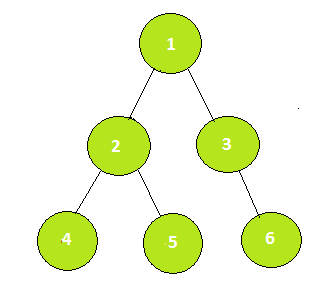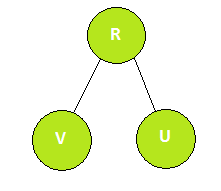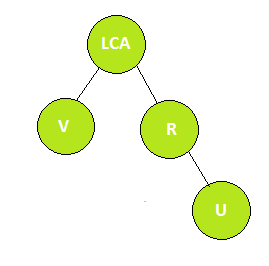给定二叉树的三个顶点U , V和R ,任务是检查R是否位于U和V之间的路径中。如果路径中不存在,则打印“否”,否则打印“是” 。
例子:
Input: U = 4, V = 6, R = 2

Output: Yes
Path 4 -> 2 -> 1 -> 3 -> 6 contains 2
Input: U = 4, V = 6, R = 5

Output: No
Path 4 -> 2 -> 1 -> 3 -> 6 does not contain 5
方法:想法是使用两个节点的最低公共祖先。在U和V之间的路径中存在R的以下情况:
- R是U和V的最低共同祖先。

- R是在U和V的最低共同祖先的左子树,是高于V。

- R在U和V的最低共同祖先的右子树中,并且在U之上。

要了解有关最低的祖先的更多信息,请在此处阅读该帖子。
下面是上述方法的实现:
C++
// CPP Program to implement the above appraoch
#include
using namespace std;
class GfG
{
public:
// Table for storing 2^ith parent
vector> table;
// Variable to store the height of the tree
int height;
// Graph
vector> Graph;
// Arrays to mark start and end time for a node
vector timeIn, timeOut;
// Timer
int time;
// constructor for initializing
// the global variables
GfG(int n)
{
// log(n) with base 2
height = (int)ceil(log2(n));
// Filling with -1 as initial
table.resize(n + 1, vector(height + 1, -1));
// Fill the graph with empty lists
Graph.resize(n + 1);
timeIn.resize(n + 1);
timeOut.resize(n + 1);
time = 0;
}
// Dfs for pre-processing sparse table and
// calculating start and end time
void dfs(int s, int p)
{
// Parent at 1 node distance is always
// it's direct parent
table[s][0] = p;
// Start time noted
timeIn[s] = ++time;
// Filling sparse table recursively
for (int i = 1; i <= height; i++)
table[s][i] = table[table[s][i - 1]][i - 1];
// Traversing children of source
for (int child : Graph[s]) {
if (child == p) continue;
dfs(child, s);
}
// End time noted
timeOut[s] = ++time;
}
// Helper function to check lowest common Ancestor
bool check(int u, int v)
{
return timeIn[u] <= timeIn[v] && timeOut[u] >= timeOut[v];
}
// Function to return Lowest Common Ancestor of U and V
int lowestCommonAncestor(int U, int V)
{
if (check(U, V)) return U;
if (check(V, U)) return V;
for (int i = height; i >= 0; i--)
{
if (!check(table[U][i], V)) U = table[U][i];
}
return table[U][0];
}
// Function that return true if R
// exists on the path between U
// and V in the given tree
bool isPresent(int U, int V, int R)
{
// Dfs
dfs(1, 1);
// Calculating LCA between U and V
int LCA = lowestCommonAncestor(U, V);
// Calculating LCA between U and R
int LCA_1 = lowestCommonAncestor(U, R);
// Calculating LCA between U and V
int LCA_2 = lowestCommonAncestor(V, R);
if (LCA == R || (LCA_1 == LCA && LCA_2 == R) ||
(LCA_2 == LCA && LCA_1 == R)) {
return true;
}
return false;
}
};
// Driver code
int main(int argc, char const *argv[])
{
// Number of vertices
int n = 6;
GfG *obj = new GfG(n);
// Create the graph
obj->Graph[1].push_back(2);
obj->Graph[2].push_back(1);
obj->Graph[1].push_back(3);
obj->Graph[3].push_back(1);
obj->Graph[2].push_back(4);
obj->Graph[4].push_back(2);
obj->Graph[2].push_back(5);
obj->Graph[5].push_back(2);
obj->Graph[3].push_back(6);
obj->Graph[6].push_back(3);
int U = 4, V = 6, R = 2;
if (obj->isPresent(U, V, R))
cout << "Yes" << endl;
else
cout << "No" << endl;
}
// This code is contributed by sanjeev2552 Java
// Java implementation of the approach
import java.util.*;
class GfG {
// Table for storing 2^ith parent
private static int table[][];
// Variable to store the height of the tree
private static int height;
// Graph
private static ArrayList > Graph;
// Arrays to mark start and end time for a node
private static int timeIn[];
private static int timeOut[];
// Timer
private static int time;
// Private constructor for initializing
// the global variables
private GfG(int n)
{
// log(n) with base 2
height = (int)Math.ceil(Math.log10(n) / Math.log10(2));
table = new int[n + 1][height + 1];
// Fill the graph with empty lists
Graph = new ArrayList >();
for (int i = 0; i <= n; i++)
Graph.add(new ArrayList());
timeIn = new int[n + 1];
timeOut = new int[n + 1];
time = 0;
}
// Filling with -1 as initial
private static void preprocessing(int n)
{
for (int i = 0; i < n + 1; i++) {
Arrays.fill(table[i], -1);
}
}
// Dfs for pre-processing sparse table and
// calculating start and end time
private static void dfs(int s, int p)
{
// Parent at 1 node distance is always
// it's direct parent
table[s][0] = p;
// Start time noted
timeIn[s] = ++time;
// Filling sparse table recursively
for (int i = 1; i <= height; i++)
table[s][i] = table[table[s][i - 1]][i - 1];
// Traversing children of source
for (int child : Graph.get(s)) {
if (child == p)
continue;
dfs(child, s);
}
// End time noted
timeOut[s] = ++time;
}
// Helper function to check lowest common Ancestor
private static boolean check(int u, int v)
{
return timeIn[u] <= timeIn[v] && timeOut[u] >= timeOut[v];
}
// Function to return Lowest Common Ancestor of U and V
private static int lowestCommonAncestor(int U, int V)
{
if (check(U, V))
return U;
if (check(V, U))
return V;
for (int i = height; i >= 0; i--) {
if (!check(table[U][i], V))
U = table[U][i];
}
return table[U][0];
}
// Function that return true if R
// exists on the path between U
// and V in the given tree
private static boolean isPresent(int U, int V, int R)
{
// Dfs
dfs(1, 1);
// Calculating LCA between U and V
int LCA = lowestCommonAncestor(U, V);
// Calculating LCA between U and R
int LCA_1 = lowestCommonAncestor(U, R);
// Calculating LCA between U and V
int LCA_2 = lowestCommonAncestor(V, R);
if (LCA == R || (LCA_1 == LCA && LCA_2 == R)
|| (LCA_2 == LCA && LCA_1 == R)) {
return true;
}
return false;
}
// Driver code
public static void main(String args[])
{
// Number of vertices
int n = 6;
GfG obj = new GfG(n);
// Create the graph
preprocessing(n);
Graph.get(1).add(2);
Graph.get(2).add(1);
Graph.get(1).add(3);
Graph.get(3).add(1);
Graph.get(2).add(4);
Graph.get(4).add(2);
Graph.get(2).add(5);
Graph.get(5).add(2);
Graph.get(3).add(6);
Graph.get(6).add(3);
int U = 4, V = 6, R = 2;
if (isPresent(U, V, R))
System.out.print("Yes");
else
System.out.print("No");
}
} C#
// C# implementation of the approach
using System;
using System.Collections.Generic;
class GfG
{
// Table for storing 2^ith parent
private static int [,]table;
// Variable to store the height of the tree
private static int height;
// Graph
private static List > Graph;
// Arrays to mark start and end time for a node
private static int []timeIn;
private static int []timeOut;
// Timer
private static int time;
// Private constructor for initializing
// the global variables
private GfG(int n)
{
// log(n) with base 2
height = (int)Math.Ceiling(Math.Log10(n) / Math.Log10(2));
table = new int[n + 1, height + 1];
// Fill the graph with empty lists
Graph = new List >();
for (int i = 0; i <= n; i++)
Graph.Add(new List());
timeIn = new int[n + 1];
timeOut = new int[n + 1];
time = 0;
}
// Filling with -1 as initial
private static void preprocessing(int n)
{
for (int i = 0; i < n + 1; i++)
{
for(int j = 0; j < height + 1; j++)
table[i, j] = -1;
}
}
// Dfs for pre-processing sparse table and
// calculating start and end time
private static void dfs(int s, int p)
{
// Parent at 1 node distance is always
// it's direct parent
table[s, 0] = p;
// Start time noted
timeIn[s] = ++time;
// Filling sparse table recursively
for (int i = 1; i <= height; i++)
table[s, i] = table[table[s, i - 1], i - 1];
// Traversing children of source
foreach (int child in Graph[s])
{
if (child == p)
continue;
dfs(child, s);
}
// End time noted
timeOut[s] = ++time;
}
// Helper function to check lowest common Ancestor
private static bool check(int u, int v)
{
return timeIn[u] <= timeIn[v] && timeOut[u] >= timeOut[v];
}
// Function to return Lowest Common Ancestor of U and V
private static int lowestCommonAncestor(int U, int V)
{
if (check(U, V))
return U;
if (check(V, U))
return V;
for (int i = height; i >= 0; i--)
{
if (!check(table[U, i], V))
U = table[U, i];
}
return table[U, 0];
}
// Function that return true if R
// exists on the path between U
// and V in the given tree
private static bool isPresent(int U, int V, int R)
{
// Dfs
dfs(1, 1);
// Calculating LCA between U and V
int LCA = lowestCommonAncestor(U, V);
// Calculating LCA between U and R
int LCA_1 = lowestCommonAncestor(U, R);
// Calculating LCA between U and V
int LCA_2 = lowestCommonAncestor(V, R);
if (LCA == R || (LCA_1 == LCA && LCA_2 == R)
|| (LCA_2 == LCA && LCA_1 == R))
{
return true;
}
return false;
}
// Driver code
public static void Main(String []args)
{
// Number of vertices
int n = 6;
GfG obj = new GfG(n);
// Create the graph
preprocessing(n);
Graph[1].Add(2);
Graph[2].Add(1);
Graph[1].Add(3);
Graph[3].Add(1);
Graph[2].Add(4);
Graph[4].Add(2);
Graph[2].Add(5);
Graph[5].Add(2);
Graph[3].Add(6);
Graph[6].Add(3);
int U = 4, V = 6, R = 2;
if (isPresent(U, V, R))
Console.Write("Yes");
else
Console.Write("No");
}
}
// This code is contributed by PrinciRaj1992 输出:
Yes时间复杂度: O(NlogN)用于预处理,logN用于查找最低的共同祖先。